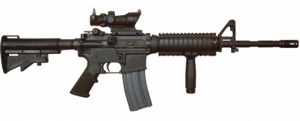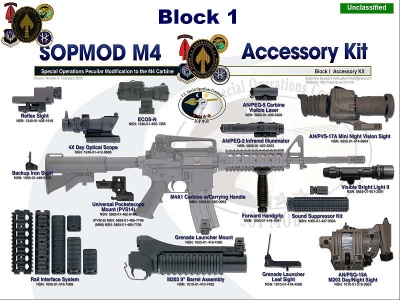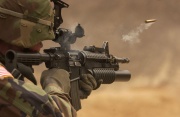M4 carbine
| |||||||||||||||||||||||||||||||||||||||||||||||||||||
The M4 Carbine is a family of firearms tracing its lineage back to earlier carbine versions of the M16, all based on the original AR-15 made by ArmaLite. It is a shorter and lighter version of the M16A2 assault rifle, achieving 80% parts commonality with the M16A2.[2] The M4 has selective fire options including semi-automatic and three-round burst (like the M16A2), while the M4A1 has a "full auto" option in place of the three-round burst.
Contents |
[edit] Overview
The M4 and variants fire 5.56x45mm NATO ammunition and are gas-operated, air-cooled, magazine-fed, selective fire firearms with a 4-position telescoping stock. Original M4 models had a flat-ended telescoping stock, but newer models are now equipped with a redesigned telescoping stock that is slightly larger with curvature at the end.[3]
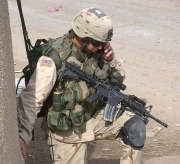
As with many carbines, the M4 is handy and more convenient to carry than a full-length rifle. While this makes it a candidate for non-infantry troops (vehicle crews, clerks and staff officers), it also makes it ideal for close quarters combat (CQC), and airborne and special operations. It has been adopted by United States Special Operations Command (USSOCOM) and is the preferred weapon of the U.S. Army Special Forces and Navy SEALs. M4's have also been fielded by the Australian Special Air Service Regiment. Malaysia purchased M4 Carbine service rifles to replace the Steyr AUG service rifles in its armed forces in 2006 and will be manufactured in Malaysia under license by SME Ordnance Sdn Bhd.[4] It is expected that these weapons will not only be used by MAF, but also will attract other users such as Police, Coast Guard and other enforcement agencies.[5]
The M4 was developed and produced for the United States government by Colt Firearms, which has an exclusive contract to produce the M4 family of weapons through 2009; however, a number of other manufacturers offer M4-like firearms. The M4A1, along with the M16A4, has mostly replaced the M16A2 ; the U.S. Air Force, for example, plans to transition completely to the M4 Carbine. The M4 is similar to much earlier compact M16 versions, such as the 1960s-era XM177 family.
The United States Marine Corps has ordered its officers (up to the rank of lieutenant colonel) and (senior) Staff Non-commissioned officers to carry the M4A1 carbine instead of the M9 handgun. This is in recognition that pistols are largely useless in current conflicts, and is in keeping with the Marine Corps motto, "Every Marine a rifleman." United States Navy corpsmen will also be issued M4A1s instead of the M9, according to the Marine Corps Times.
[edit] History and variants
- For more details on M4 Carbine variants, see AR-15 variants
Except for the very first delivery order, all U.S. military-issue M4 and M4A1 possess a flat-top NATO M1913-specification (Picatinny) rail on top of the receiver for attachment of optical sights and other aiming devices — Trijicon TA01 and TA31 Advanced Combat Optical Gunsights (ACOG), EOTech 550 series holographic sights, and Aimpoint M68 Close Combat Optic (M68 CCO) being the favorite choices — and a detachable rail-mounted carrying handle. Standards are the Colt Model 920 (M4) and 921 (M4A1).
Variants of the carbine built by different manufacturers are also in service with many other foreign special forces units, such as the Australian Special Air Service Regiment (SASR). While the SASR uses weapons of essentially the same pattern built by Colt for export (Colt uses different models to separate weapons for the U.S. military and those for commercial/export purposes), the British SAS uses a variant on the basic theme, the SFW built by Diemaco of Canada. Although Diemaco was purchased by Colt and renamed Colt Canada, the Diemaco names and related firearms were kept.
[edit] M4/M4A1
The major difference between these models is that the M4 has a "S-1-3" (safe/semi-automatic/3-round burst) trigger group while the M4A1 has a "S-1-F" (safe/semi-automatic/fully automatic) trigger group.
[edit] M4 MWS (Modular Weapon System)

Colt Model 925 carbines were tested fitted with the Knight's Armament Corporation (KAC) M4 RAS under the designation M4E2, but this designation appears to have been scrapped in favor of mounting this system to existing carbines without changing the designation. The U.S. Army Field Manual specifies for the Army that adding the Rail Accessory System (RAS) turns the weapon into the M4 MWS or Modular Weapon System.
[edit] M4A1
The M4A1 carbine is a variant of the basic M4 carbine intended for special operations use. The M4A1 is used by almost all U.S special operation units. The M4A1 Carbine is especially favored by counter-terrorist and special operations units for close quarters combat because of the carbine's compactness and firepower. These features are also very useful in urban warfare. Although the M4 does not have as great of an effective range as the longer M16, many military analysts consider engagement with a non-specialized small arm above a range of 300 meters to be unnecessary. It is effective at ranges of 150 meters or less and has a maximum effective range of about 500-600 meters.[6]
In the last few years, M4A1 carbines have been refit or received straight from factory with barrels with a thicker profile under the handguard. This is for a variety of reasons such as heat dissipation during full-auto and accuracy as a byproduct of barrel weight. These heavier barrel weapons are also fitted with a heavier buffer known as the H2. Out of three sliding weights inside the buffer, the H2 possesses two tungsten weights and one steel weight, versus the standard H buffer, which uses one tungsten weight and two steel weights. These weapons, known by Colt as the Model 921HB (for Heavy Barrel), have also been designated M4A1, and as far as the government is concerned the M4A1 represents both the 921 and 921HB.
[edit] SOPMOD Block I
USSOCOM developed the Special Operations Peculiar Modification (SOPMOD) Block I kit for the carbines used by units under its jurisdiction. The kit features an M4A1 carbine, a Rail Interface System (RIS) handguard developed by Knight's Armament Company, a shortened quick-detachable M203 grenade launcher and leaf sight, a KAC sound suppressor, a KAC back-up rear sight, an Insight Technologies AN/PEQ-2A visible laser/infrared designator, along with Trijicon's ACOG and Reflex sights, and a night vision sight. This kit was designed to be configurable (modular) for various missions, and the kit is currently in service with special operations units.
[edit] SOPMOD Block II
A second-generation SOPMOD kit (now known as SOPMOD II) is currently under development, with many different manufacturers competing for a contract. Notable bidders include Knight's Armament Company, Atlantic Research Marketing Systems (ARMS), and Lewis Machine & Tools. Daniel Defense has won the contract for the RIS-II, the next generation of rail handguards.
[edit] Design
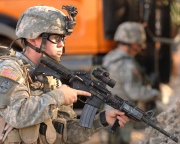
The M4/M4A1 5.56 mm Carbine is a gas-operated, air-cooled, magazine-fed, selective fire, shoulder-fired weapon with a telescoping stock. A shortened variant of the M16A2 rifle with a 14.5 in (368 mm) barrel, the M4 provides the individual soldier operating in close quarters the capability to engage targets at extended range with accurate, lethal fire. The original M4 Carbine has semi-automatic and three-round burst fire modes, while the M4A1 has "semi" and "full auto", with no three-round burst. The M4 Carbine achieves over 80% commonality with the M16A2 rifle and was intended to replace the .45 ACP M3 submachine guns and selected M9 pistols and M16 rifle series with most Army units (this plan was thought to be changed with the development of the XM29 OICW and the XM8 carbine. However, both projects were cancelled.). The M4 Carbine is also capable of mounting the M203 grenade launcher,the M203A1 with a 9-inch barrel as opposed to the standard 12-inch barrel of the M203 used on the M16 series of rifle.
Some features of the M4 and M4A1 compared to a full-length M16-series rifle include:
- Compact size
- Shorter barrel 14.5 in (368 mm)
- Telescoping buttstock
However, there have been some criticisms of the carbine, such as lower muzzle velocities and louder report due to the shorter barrel, additional stress on parts because of the shorter gas system, and a tendency to overheat faster than the M16A2.
[edit] Accessories
Like all the variants of the M16 assault rifle, the M4 Carbine and the M4A1 Carbine can be fitted with many accessories, such as night vision devices, laser pointers, telescopic sights, bipods, either the M203 or M320 grenade launchers, the M26 MASS shotgun, and anything else compatible with a MIL-STD-1913 Picatinny rail.
Other common accessories include the AN/PEQ-2, Advanced Combat Optical Gunsight (ACOG), and M68 Aimpoint. EOTech holographic weapon sights are to be part of the SOPMOD II package. Visible and IR (infrared) lights of various manufacturers are also commonly attached using various mounting methods. As with all versions of the M16, the M4 accepts a blank-firing attachment (BFA).
[edit] M4 Carbine effectiveness
An April 2002 presentation by the Natick Soldier Center presented by LTC Charlie Dean and SFC Sam Newland reported on lessons learned from M4 use in Afghanistan (such as use during Operation Anaconda):
- 34% of soldiers reported that their M4's handguards rattle and become excessively hot when firing.
- 15% reported that they had trouble zeroing the M68 reflex sight.
- 35% added barber brushes and 24% added dental picks to their cleaning kits.
- Soldiers reported the following malfunctions:
- 20% reported double-feeding.
- 15% reported feeding jams.
- 13% reported that feeding problems were due to magazines.
- 89% of soldiers reported confidence in the weapon.
- 20% were dissatisfied with its ease of maintenance.
Soldiers requested the following changes:
- 55% requested the firearm be made lighter
- 20% requested a larger magazine
[edit] 2007 Dust Test
In the fall of 2007, the Army tested the M4 against three other carbines in "sandstorm conditions" at Aberdeen Proving Ground, Maryland: the Heckler & Koch XM8 rifle, FNH USA’s SOF Combat Assault Rifle (SCAR) and the Heckler & Koch HK416. Ten of each type of rifle were used to fire 6,000 rounds each, for a total of 60,000 rounds per rifle type.[7] The M4 suffered far more stoppages than its competitors: 882 stoppages, 19 requiring an armorer to fix. The XM8 had the fewest stoppages, 116 minor stoppages and 11 major ones, followed by the FN SCAR with 226 stoppages and the HK416 with 233.[8][9] The Army now has plans to improve the M4 with a new cold-hammer-forged barrel to give longer life and more reliable magazines to reduce the stoppages. Magazine failures caused 239 of the M4's 882 failures. Army officials said the new magazines could be combat-ready by spring if testing goes well.[10]
[edit] Trademark issues
Colt has held a US trademark on the word "M4"[11] Many manufacturers produce firearms that come very close in terms of appearance to a military M4, sometimes colloquially referred to as an "M4gery"[12] (pronounced ĕm'fôr jə-rē, a portmanteau of "M4" and "forgery"). Colt has maintained that it retains sole rights to the M4 name and design. Other manufacturers had long maintained that Colt had been overstating their rights — "M4" has now become more of a generic term for a shortened M16/AR-15. In April 2004, Colt filed a lawsuit against Heckler & Koch and Bushmaster Firearms, claiming acts of trademark infringement, trade dress infringement, trademark dilution, false designation of origin, false advertising, patent infringement, unfair competition, and deceptive trade practices. Heckler & Koch later settled out of court, changing one product's name from "HK M4" to "HK416". However, on December 8th, 2005, a District court judge in Maine granted a summary judgment in favor of Bushmaster Firearms, dismissing all of Colt's claims except for false advertising. On the latter claim, Colt could not recover monetary damages. More importantly, the court ruled that "M4" was now a generic name, and that Colt's trademark should be revoked.
[edit] U.S. citizen ownership
Sales of select-fire or full automatic M4s by Colt are restricted to military and civilian law enforcement. Only under special circumstances can a private citizen own an M4 Carbine in a select-fire or fully automatic configuration. While many machine guns can be legally owned with a proper tax stamp from the Bureau of Alcohol, Tobacco, Firearms and Explosives, an amendment to the Firearm Owners Protection Act of 1986 barred the transfer to private citizens of machine guns made in the U.S. after May 19, 1986. The only exception was for Special Occupational Taxpayers (SOT): licensed machine gun dealers with demonstration letters, manufacturers, and those dealing in exports and imports. As such, only the earliest Colt M4 prototypes built prior to May 19, 1986 would be legal to own by civilians not in the categories mentioned. However, as US firearms law considers the lower receiver of a M16/M4 type rifle to be the "firearm" (the serial numbered and, in the case of machine guns, registered under federal law, part of the weapon), a registered Colt M16 (much more common than an actual M4) may be configured as an M4 by replacing the M16 upper receiver/barrel assembly with an M4 top half, and replacing the fixed rifle stock with a 4-position telescoping M4 stock.
[edit] Resources
| Gun Owners' Resource has the following relevant documents available for free download for the M4 carbine and/or its variants: |
- M16A2, M4, M4A1 Unit and Direct Support Maintenance Manual - document TM 9-1005-319-23 (US Army), TO 11 W35-5-42 (USAF); Departments of the Army and Air Force, Washington, DC; 9 April 1997. Approved for public release. (.PDF file, 325 pgs, 2.51MB)
- M16A2, M4, M4A1 Operator' Manual - US Army document TM 9-1005-319-10, Headquarters, Department of the Army, Washington, DC, August 1986 (.PDF file, 176 pgs, 3MB)

This article is either missing some diagrams which would help to illustrate a proper breakdown of the firearm in question or the diagrams which are here are inadequate. This article could use more input to fill in the missing bits. You (yes, you!) can help Gunsopedia provide more comprehensive information to our users by using your own knowledge to add to it.
[edit] References
- ↑ "The FY2006 current ARNG requirement for M4 Carbines is 60,943 rifles at a cost of $1k each." globalsecurity.org
- ↑ A Short History Of The M-4 Carbine, part 2, specialoperations.com.
- ↑ Photo of the Colt M4 with the redesigned telescoping stock
- ↑ Malaysia has license to make M4 assault rifles The Star 2007-11-05
- ↑ M4 carbine also used by Royal Malaysian Police, Malaysian Maritime Enforcement Agency and others Smeordnance.com
- ↑ U.S. Army Fact Files Army.mil
- ↑ M4 Carbine Fares Poorly in Dust Test Military.com
- ↑ Defense Tech: ...And Here's the Rest of the M4 Story Defensetech.org
- ↑ Newer carbines outperform M4 in dust test - Army News, opinions, editorials, news from Iraq, photos, reports - Army Times Armytimes.com
- ↑ M4 may get tougher barrel, better mags - Army News, opinions, editorials, news from Iraq, photos, reports - Army Times Armytimes.com
- ↑ US Trademark serial number 76335060 registration number 2734001 http://tess2.uspto.gov/bin/showfield?f=doc&state=75n9nl.3.13
- ↑ Urban Dictionary: m4gery Urbandictionary.com
[edit] External links
- Colt Official M4 Military page and Colt M4 Law Enforcement page
- US Army M4 fact file
- The AR-15/M16 Magazine FAQ
- U.S. Army Won't Field Rifle Deemed Superior to M4
- The USA's M4 Carbine Controversy
| The M4 carbine is part of a series of pages on guns derived from Stoner's AR-10 and AR-15. | |
|---|---|
| AR-10 • AR-15 • AR-57 • AR-831 • C7/C8 • CAR • CAR-15 • Colt 9mm SMG • CQ • CQBR • GatMalite • GPC • HK416 • HK417 • MSSR • MKA 1919 • M110 • M16 • M16K • M231 • M27 • M4 • M4A2/A3 • M6 • REC7 • Recon Rifle • SDM-R • SAM-R • Shrike • SPR • SR-25 • SR-47 • SR-556 • T-14 • T-15 • T-16 • T-17 • T65 • T86 • T91 | |
| Handguns | M9 | M11 | MEU(SOC) | Mk 23 | Mk 24 | |
|---|---|---|
| Rifles | Assault and Battle | M16 | Mk 14 | Mk 17 |
| Carbine | HK416 | M4 | Mk 18 | |
| Designated Marksman | DMR | M14 | M39 | Mk 12 | SAM-R | SDM-R | SEAL Recon Rifle | |
| Sniper | M24 | M40 | M107 | M110 | Mk 11 | Mk 15 | |
| Shotguns | M26 | M590 | M870 | M1014 | |
| Submachine guns | MP5N | P90 | |
| Machine guns | M2HB (still!) | M240B | M249 and Mk 46 | Mk 43 | |
| Grenade launchers | M203 | M32 | M320 | M79 | Mk 19 | Mk 47 | |
| Mortars | M120 | M224 | M252 | |
| Rockets | M3 | M72 series | M136 | M141 | M202A1 | Mk 153 | |
| Missiles | FGM-172 | FGM-148 | FIM-92 | |
| Cartridges | 12-gauge | 5.7x28mm | 9x19mm NATO | .45 ACP | 5.56x45mm NATO | 7.62x51mm NATO | .50 BMG (12.7x99mm NATO) | 40x46mm | |
